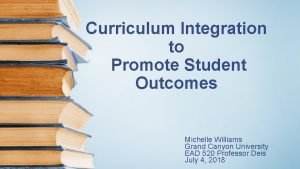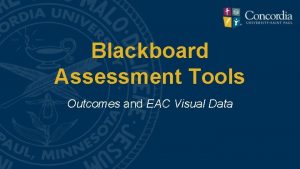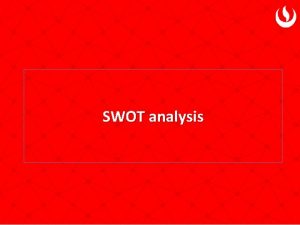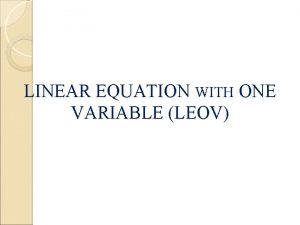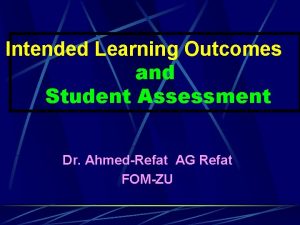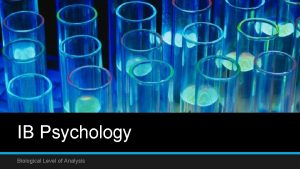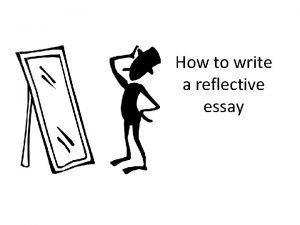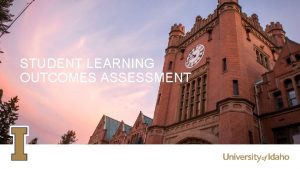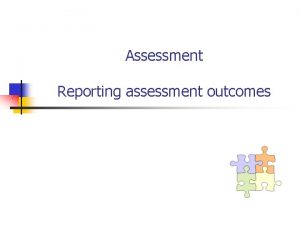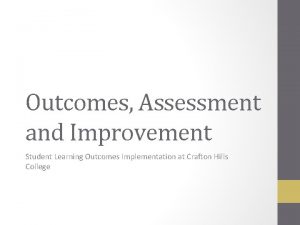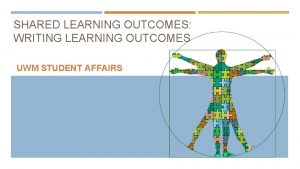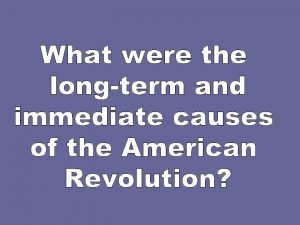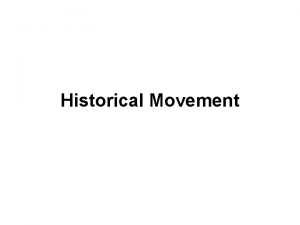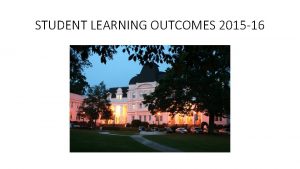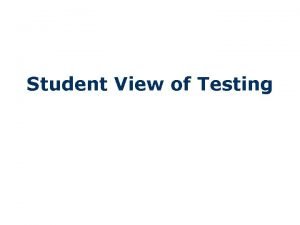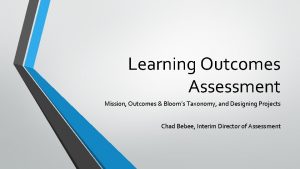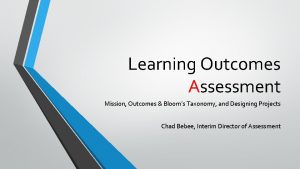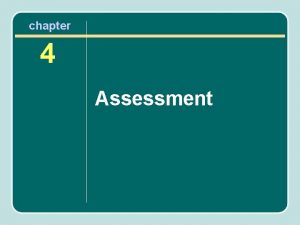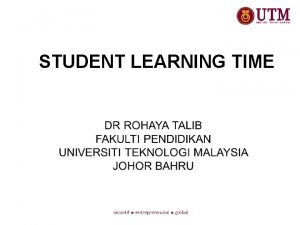STUDENT LEARNING OUTCOMES ASSESSMENT HISTORICAL VIEW The importance



















- Slides: 19

STUDENT LEARNING OUTCOMES ASSESSMENT

HISTORICAL VIEW • The importance and integrity of assessing student learning outcomes is not new • The University of Idaho is accredited through the Northwest Commission on Colleges and Universities (NWCCU). This accreditation provides our students access to federal financial aid programs. • The U. S. Department of Education first required accrediting bodies to examine student learning outcomes as part of “recognition, ” in 1989. Almost 30 years ago.

NATIONAL CLIMATE Pressure for institutions to use direct measures of student learning attainment and product evidence of learning, by accreditors, has continually increased due to national influences Institutions will be held to higher standards regarding retention and graduation rates, and student learning outcomes.

IEA’S ROLE • IEA’s role is to support programs in meeting expectations and requirements • We don’t want any program to be embarrassed if their plan is scrutinized – we are here to help programs develop, implement and use plans that meet best practices • NWCCU will look at assessment plans and evidence of use of data in April, Spring 2018. Both a report and site visit will take place. • IEA’s role is to help you be ready

GENERAL EXPECTATIONS • Chair is responsible for assessment planning and reporting • Faculty are the best to carry out assessment in their discipline • Assessment results are used solely to assess the program, not the faculty • Approach should be manageable and simple; should not interfere with the delivery of the education it is supposed to be improving • Collaboration and inclusion should be stressed during assessment initiatives • Faculty and staff are expected to use the results! It’s all about continuous improvement.

ASSESSMENT TIMELINE

ACCESSING ASSESSMENT SYSTEM • Everyone with Vandal. Web access already has permissions to access assessment plans and reports • Access from UI IEA webpage: https: //www. uidaho. edu/provost/iea/accreditationevaluation/assessment

ACCESSING ASSESSMENT SYSTEM

ACCESSING ASSESSMENT SYSTEM Login as normal to the Vandal. Web interface

ACCESSING ASSESSMENT SYSTEM

ACCESSING ASSESSMENT SYSTEM 1. Select “assessment” under your college 2. Select your program 3. The template is pre-loaded with your learning outcomes, measures, and benchmarks from the prior year. You can “edit” these based on feedback received last cycle. The feedback should be attached to the plan for you to view. 4. You may upload supporting documentation and evidence and see the prior year plan using the appropriate links from this template

ACCESSING ASSESSMENT SYSTEM

COMMON FEEDBACK ON PLANS Our focus for this past cycle was to revise our student learning outcomes to be student-centered terms that are measurable and realistic. Template: “The student will be able to ___Bloom’s Taxonomy verb ____. . . (specific learning student will demonstrate/work product used to show this) Other focus was to revise as needed, our direct measures to clearly specify the direct measure (student work product to be evaluated) and tool used to evaluate it. Programs were asked to review their benchmarks to identify a “stretch benchmark. ” For many programs, they may need to collect baseline data and indicate this in their plan.

FINDINGS/CHANGES Only report relevant findings and changes that relate to the student learning outcome being measured. Some plans may not have findings if their plan underwent major revisions this past cycle. The changes to the plan and assessment practices would be detailed in the plan. Some programs may be converting to a 3 -year cycle, in which all learning outcomes are assessed over 3 years, with 1 -2 assessed and reported on each year. These plans are uploaded to the system as an attachment.

RUBRIC USED FOR FEEDBACK It is common practice and was recommended by NWCCU in the last 7 -year accreditation report, that the plans and reports are reviewed regularly. IEA does this review and applies a relatively generic rubric to the plans. This process is intended as formative and is intended to be helpful, and not to “grade” your program’s plan and report. Most plans at UI currently fall into the “beginning” or “developing” categories. To fall into the “exceptional” category, a plan must be mature and consistent over time. The goal of this rubric is to help programs move in that direction; not to point out its short-comings.

IEA IS HERE TO HELP IEA monitors NWCCU requirements for student learning outcomes assessment, as well as best practices in this area. We can provide feedback intermittently throughout the cycle on your plan and report, as well as meet with you or your team upon request. Email assessment@uidaho. edu with any assessment questions or concerns. The University Assessment Committee will have faculty representation from each college and serve to increase transparency and communication between IEA and colleges beginning Fall 2017.

NWCCU VISIT What to expect? • Purpose: “It is to assist institutions in determining if the process of outcomes assessment will lead them to a successful Year Seven self-evaluation and peer evaluation. ” • Requires both macro and micro-level review. We provide a narrative of the overall process, and two examples of the assessment process. At the Mid. Cycle Evaluation training, they mentioned one strong and one weak example. However, they can ask for anything they want.

NWCCU VISIT (CONT. ) What are they looking for? • Regular/on-going assessment; communication and use of results • Cycles of assessment • Collecting data that actually measures outcome; no arbitrary data • Campus website that celebrates use • Meaningful, assessable, and verifiable data (replicable) • Data that is reviewed as a team and put into a narrative statement • Numbers in context – what do the scores actually mean in terms of learning/student achievement?

QUESTIONS?
 Ncbts student learning outcomes
Ncbts student learning outcomes Domains and competencies of the ppst
Domains and competencies of the ppst Student learning space login page
Student learning space login page Curriculum integration to promote student outcomes
Curriculum integration to promote student outcomes Blackboard outcomes assessment
Blackboard outcomes assessment Examples of learning outcomes
Examples of learning outcomes Water cycle learning outcomes
Water cycle learning outcomes Objectives of teaching notice writing
Objectives of teaching notice writing Learning outcomes of swot analysis
Learning outcomes of swot analysis Objectives of teaching rhymes
Objectives of teaching rhymes Example of learning objectives
Example of learning objectives Photosynthesis chlorophyll
Photosynthesis chlorophyll Objectives of photosynthesis
Objectives of photosynthesis Learning outcomes of linear equations in one variable
Learning outcomes of linear equations in one variable Learning outcomes generator
Learning outcomes generator Objectives of reported speech
Objectives of reported speech Purpose of learning outcomes
Purpose of learning outcomes Purpose of output devices
Purpose of output devices Ib psychology learning outcomes
Ib psychology learning outcomes How to write an introduction for a reflective essay
How to write an introduction for a reflective essay



